University Risk Management: Analysis and Preventative Measures Report
VerifiedAdded on 2023/06/05
|40
|5122
|294
Report
AI Summary
This report provides a comprehensive analysis of risk management within a business context. It begins by outlining a risk assessment framework, including identifying potential hazards like third-party discrimination, slip and fall accidents, and financial risks. The report then delves into the risk assessment matrix, evaluating the likelihood and consequences of various incidents, such as terrorist attacks, fires, and product thefts. Furthermore, the report details the steps involved in conducting a risk assessment, from risk identification to evaluation. It also explores preventative measures that organizations should implement to mitigate identified risks, including diversity training, floor safety protocols, and financial planning. Finally, the report discusses new procedures encompassing evacuation of staff, security of cash, handling of chemical hazards, workplace accidents, and hazard identification, emphasizing the importance of a safe and healthy work environment, proper key and accounting management, and the appointment of floor marshals.
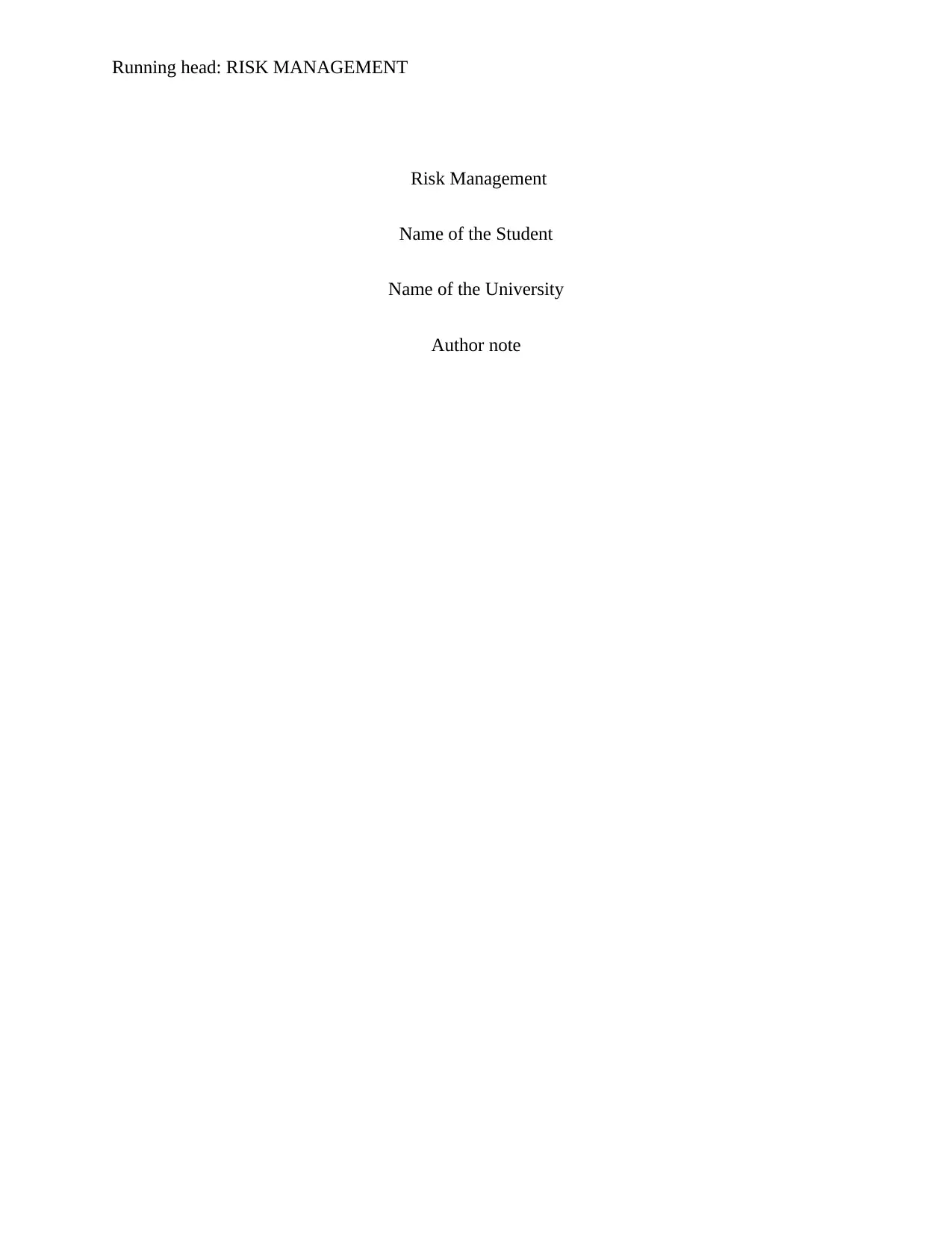
Running head: RISK MANAGEMENT
Risk Management
Name of the Student
Name of the University
Author note
Risk Management
Name of the Student
Name of the University
Author note
Paraphrase This Document
Need a fresh take? Get an instant paraphrase of this document with our AI Paraphraser
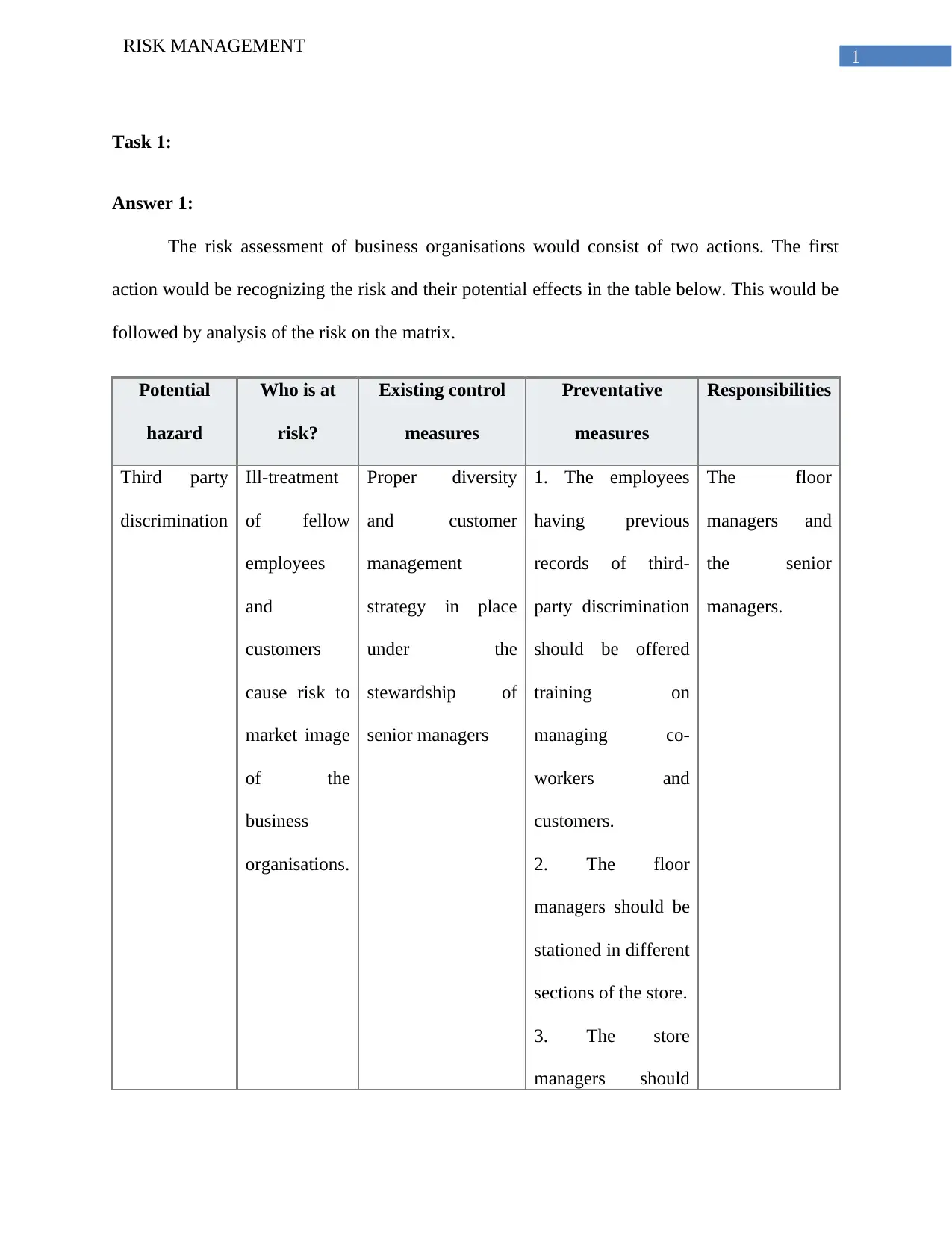
1
RISK MANAGEMENT
Task 1:
Answer 1:
The risk assessment of business organisations would consist of two actions. The first
action would be recognizing the risk and their potential effects in the table below. This would be
followed by analysis of the risk on the matrix.
Potential
hazard
Who is at
risk?
Existing control
measures
Preventative
measures
Responsibilities
Third party
discrimination
Ill-treatment
of fellow
employees
and
customers
cause risk to
market image
of the
business
organisations.
Proper diversity
and customer
management
strategy in place
under the
stewardship of
senior managers
1. The employees
having previous
records of third-
party discrimination
should be offered
training on
managing co-
workers and
customers.
2. The floor
managers should be
stationed in different
sections of the store.
3. The store
managers should
The floor
managers and
the senior
managers.
RISK MANAGEMENT
Task 1:
Answer 1:
The risk assessment of business organisations would consist of two actions. The first
action would be recognizing the risk and their potential effects in the table below. This would be
followed by analysis of the risk on the matrix.
Potential
hazard
Who is at
risk?
Existing control
measures
Preventative
measures
Responsibilities
Third party
discrimination
Ill-treatment
of fellow
employees
and
customers
cause risk to
market image
of the
business
organisations.
Proper diversity
and customer
management
strategy in place
under the
stewardship of
senior managers
1. The employees
having previous
records of third-
party discrimination
should be offered
training on
managing co-
workers and
customers.
2. The floor
managers should be
stationed in different
sections of the store.
3. The store
managers should
The floor
managers and
the senior
managers.
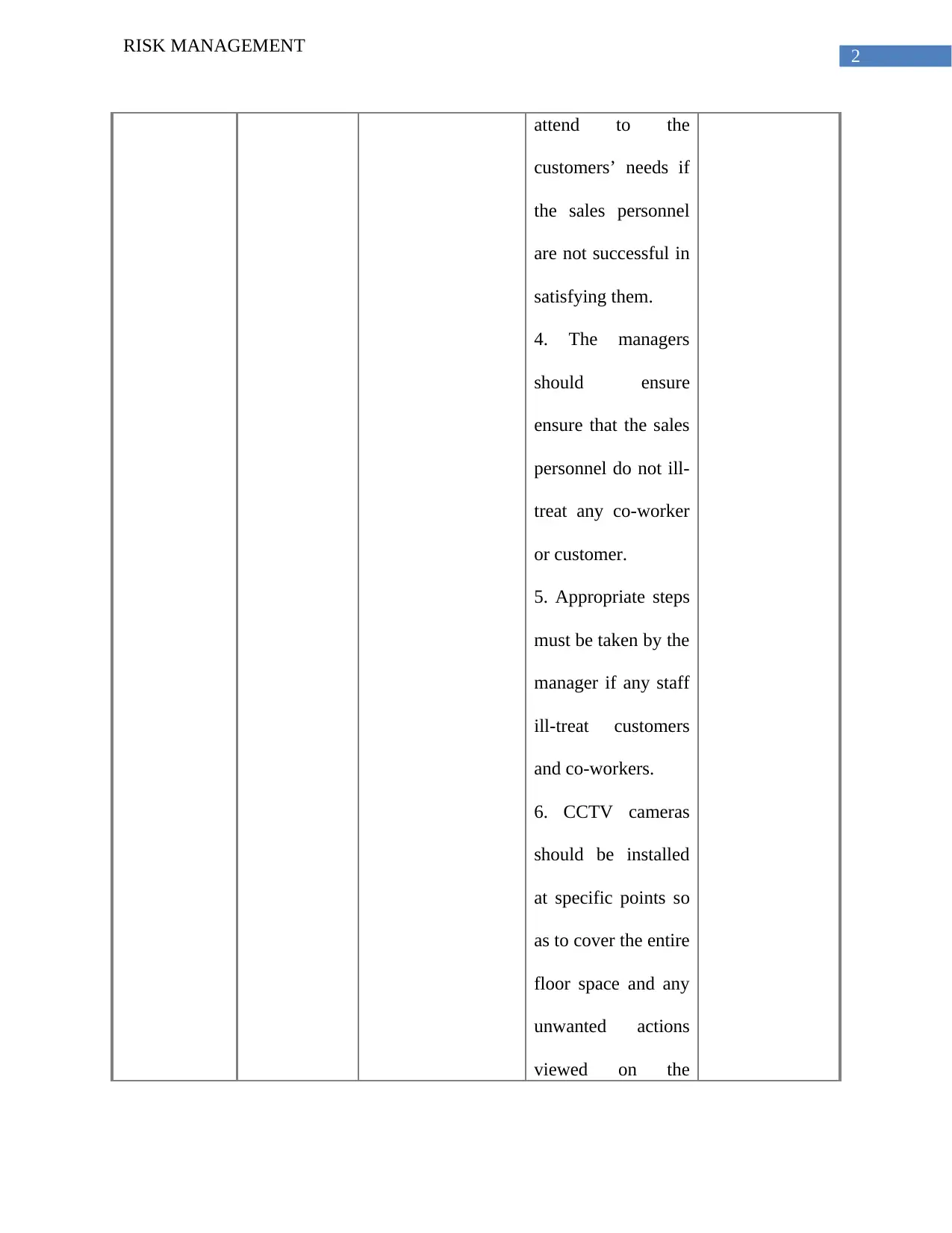
2
RISK MANAGEMENT
attend to the
customers’ needs if
the sales personnel
are not successful in
satisfying them.
4. The managers
should ensure
ensure that the sales
personnel do not ill-
treat any co-worker
or customer.
5. Appropriate steps
must be taken by the
manager if any staff
ill-treat customers
and co-workers.
6. CCTV cameras
should be installed
at specific points so
as to cover the entire
floor space and any
unwanted actions
viewed on the
RISK MANAGEMENT
attend to the
customers’ needs if
the sales personnel
are not successful in
satisfying them.
4. The managers
should ensure
ensure that the sales
personnel do not ill-
treat any co-worker
or customer.
5. Appropriate steps
must be taken by the
manager if any staff
ill-treat customers
and co-workers.
6. CCTV cameras
should be installed
at specific points so
as to cover the entire
floor space and any
unwanted actions
viewed on the
⊘ This is a preview!⊘
Do you want full access?
Subscribe today to unlock all pages.

Trusted by 1+ million students worldwide
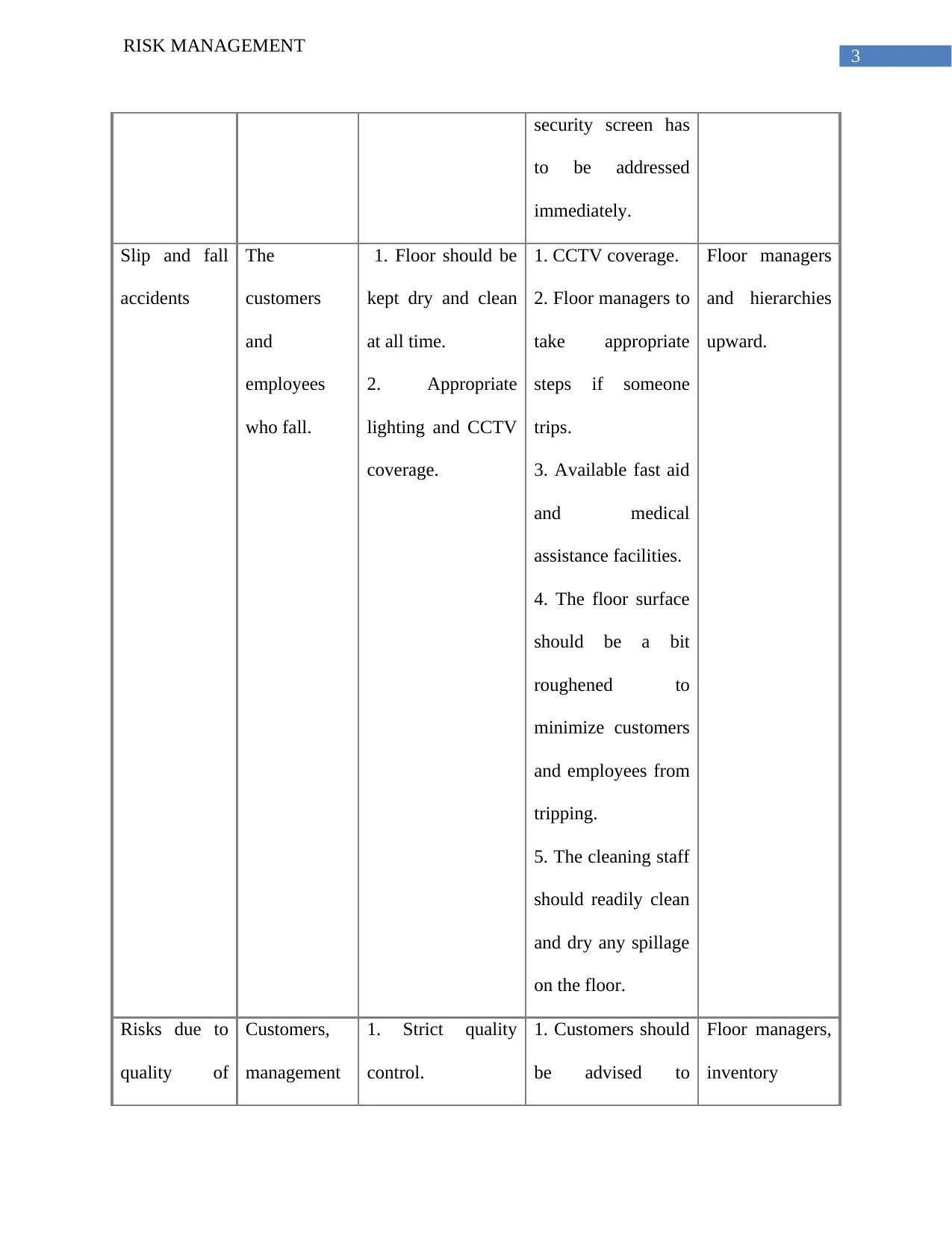
3
RISK MANAGEMENT
security screen has
to be addressed
immediately.
Slip and fall
accidents
The
customers
and
employees
who fall.
1. Floor should be
kept dry and clean
at all time.
2. Appropriate
lighting and CCTV
coverage.
1. CCTV coverage.
2. Floor managers to
take appropriate
steps if someone
trips.
3. Available fast aid
and medical
assistance facilities.
4. The floor surface
should be a bit
roughened to
minimize customers
and employees from
tripping.
5. The cleaning staff
should readily clean
and dry any spillage
on the floor.
Floor managers
and hierarchies
upward.
Risks due to
quality of
Customers,
management
1. Strict quality
control.
1. Customers should
be advised to
Floor managers,
inventory
RISK MANAGEMENT
security screen has
to be addressed
immediately.
Slip and fall
accidents
The
customers
and
employees
who fall.
1. Floor should be
kept dry and clean
at all time.
2. Appropriate
lighting and CCTV
coverage.
1. CCTV coverage.
2. Floor managers to
take appropriate
steps if someone
trips.
3. Available fast aid
and medical
assistance facilities.
4. The floor surface
should be a bit
roughened to
minimize customers
and employees from
tripping.
5. The cleaning staff
should readily clean
and dry any spillage
on the floor.
Floor managers
and hierarchies
upward.
Risks due to
quality of
Customers,
management
1. Strict quality
control.
1. Customers should
be advised to
Floor managers,
inventory
Paraphrase This Document
Need a fresh take? Get an instant paraphrase of this document with our AI Paraphraser
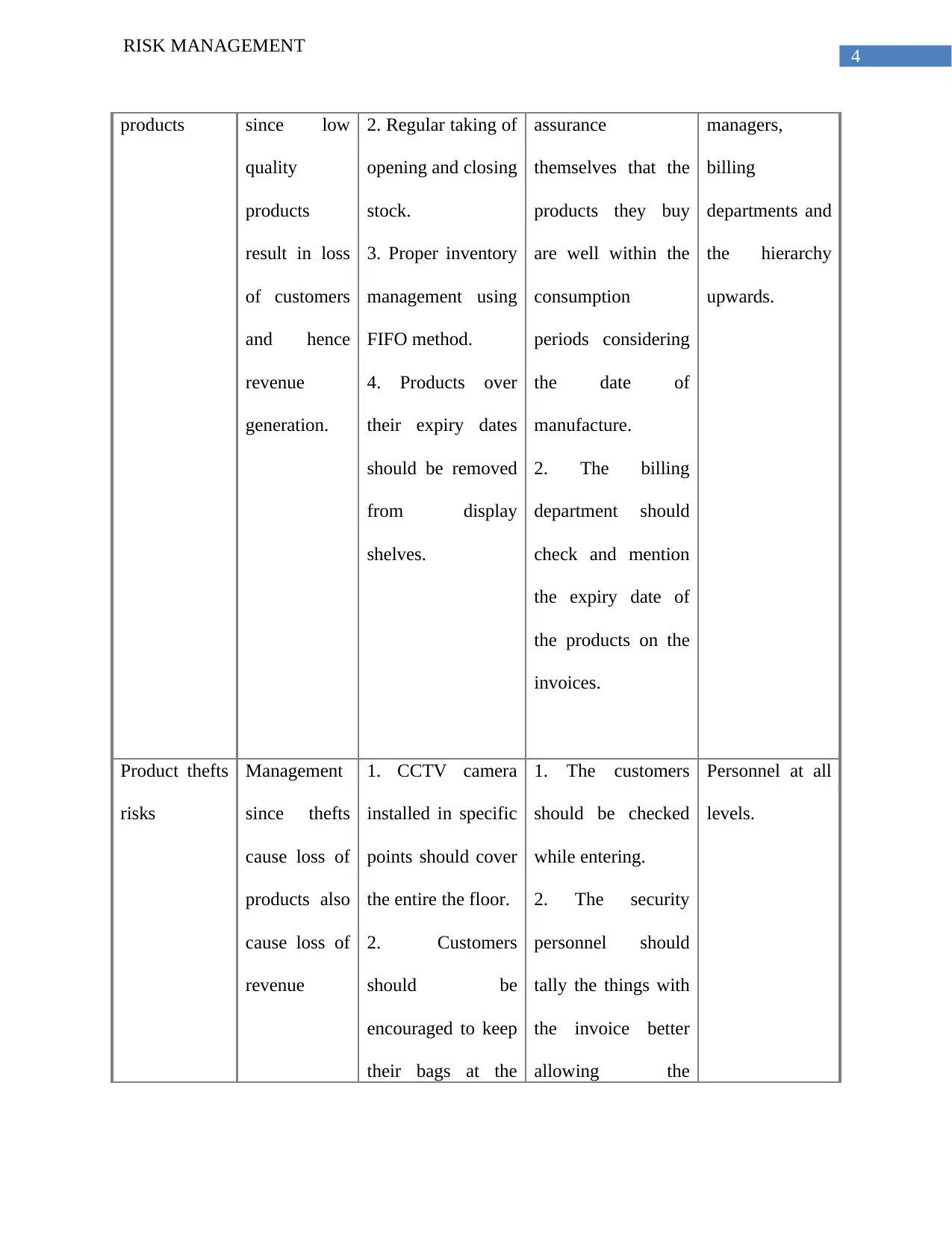
4
RISK MANAGEMENT
products since low
quality
products
result in loss
of customers
and hence
revenue
generation.
2. Regular taking of
opening and closing
stock.
3. Proper inventory
management using
FIFO method.
4. Products over
their expiry dates
should be removed
from display
shelves.
assurance
themselves that the
products they buy
are well within the
consumption
periods considering
the date of
manufacture.
2. The billing
department should
check and mention
the expiry date of
the products on the
invoices.
managers,
billing
departments and
the hierarchy
upwards.
Product thefts
risks
Management
since thefts
cause loss of
products also
cause loss of
revenue
1. CCTV camera
installed in specific
points should cover
the entire the floor.
2. Customers
should be
encouraged to keep
their bags at the
1. The customers
should be checked
while entering.
2. The security
personnel should
tally the things with
the invoice better
allowing the
Personnel at all
levels.
RISK MANAGEMENT
products since low
quality
products
result in loss
of customers
and hence
revenue
generation.
2. Regular taking of
opening and closing
stock.
3. Proper inventory
management using
FIFO method.
4. Products over
their expiry dates
should be removed
from display
shelves.
assurance
themselves that the
products they buy
are well within the
consumption
periods considering
the date of
manufacture.
2. The billing
department should
check and mention
the expiry date of
the products on the
invoices.
managers,
billing
departments and
the hierarchy
upwards.
Product thefts
risks
Management
since thefts
cause loss of
products also
cause loss of
revenue
1. CCTV camera
installed in specific
points should cover
the entire the floor.
2. Customers
should be
encouraged to keep
their bags at the
1. The customers
should be checked
while entering.
2. The security
personnel should
tally the things with
the invoice better
allowing the
Personnel at all
levels.
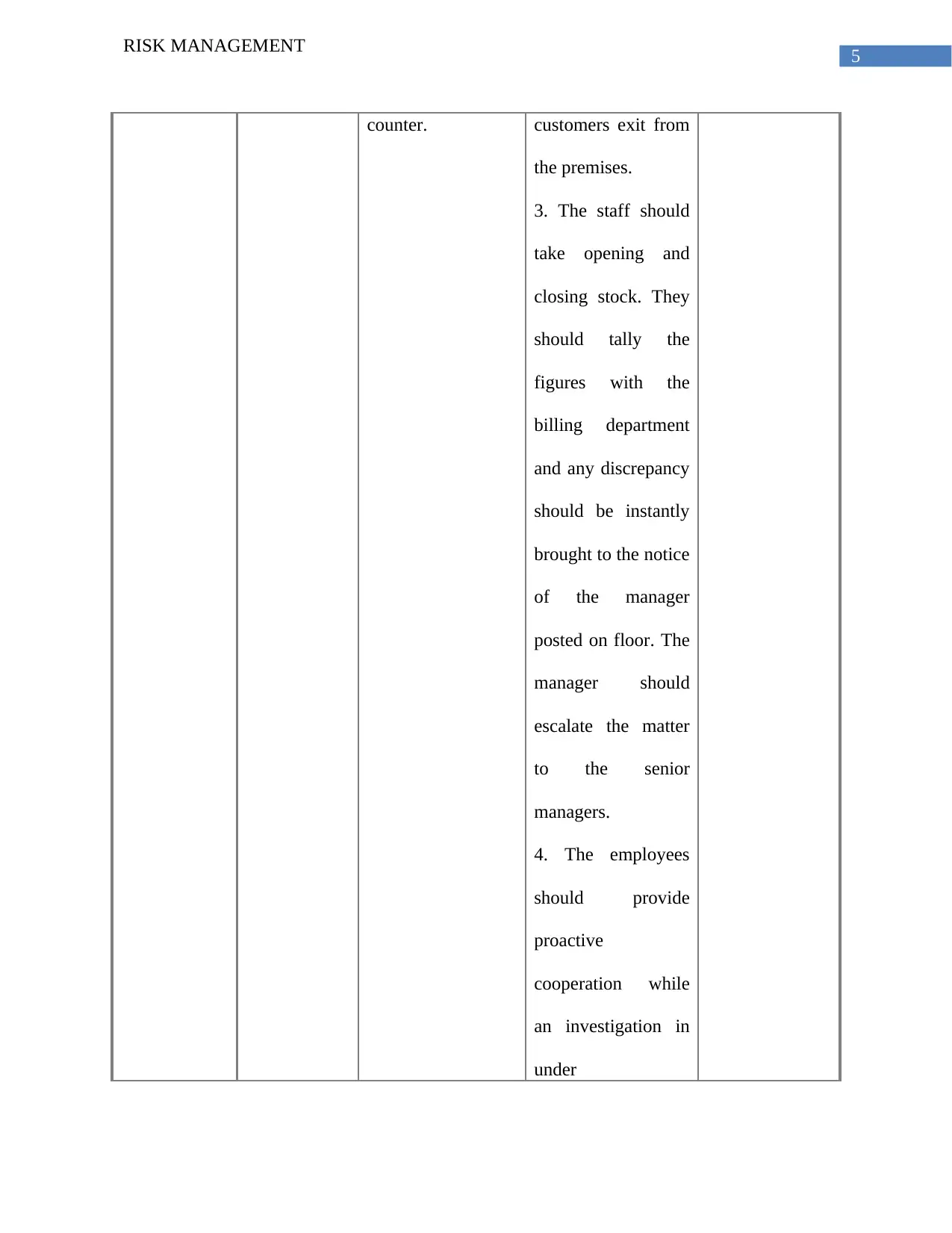
5
RISK MANAGEMENT
counter. customers exit from
the premises.
3. The staff should
take opening and
closing stock. They
should tally the
figures with the
billing department
and any discrepancy
should be instantly
brought to the notice
of the manager
posted on floor. The
manager should
escalate the matter
to the senior
managers.
4. The employees
should provide
proactive
cooperation while
an investigation in
under
RISK MANAGEMENT
counter. customers exit from
the premises.
3. The staff should
take opening and
closing stock. They
should tally the
figures with the
billing department
and any discrepancy
should be instantly
brought to the notice
of the manager
posted on floor. The
manager should
escalate the matter
to the senior
managers.
4. The employees
should provide
proactive
cooperation while
an investigation in
under
⊘ This is a preview!⊘
Do you want full access?
Subscribe today to unlock all pages.

Trusted by 1+ million students worldwide
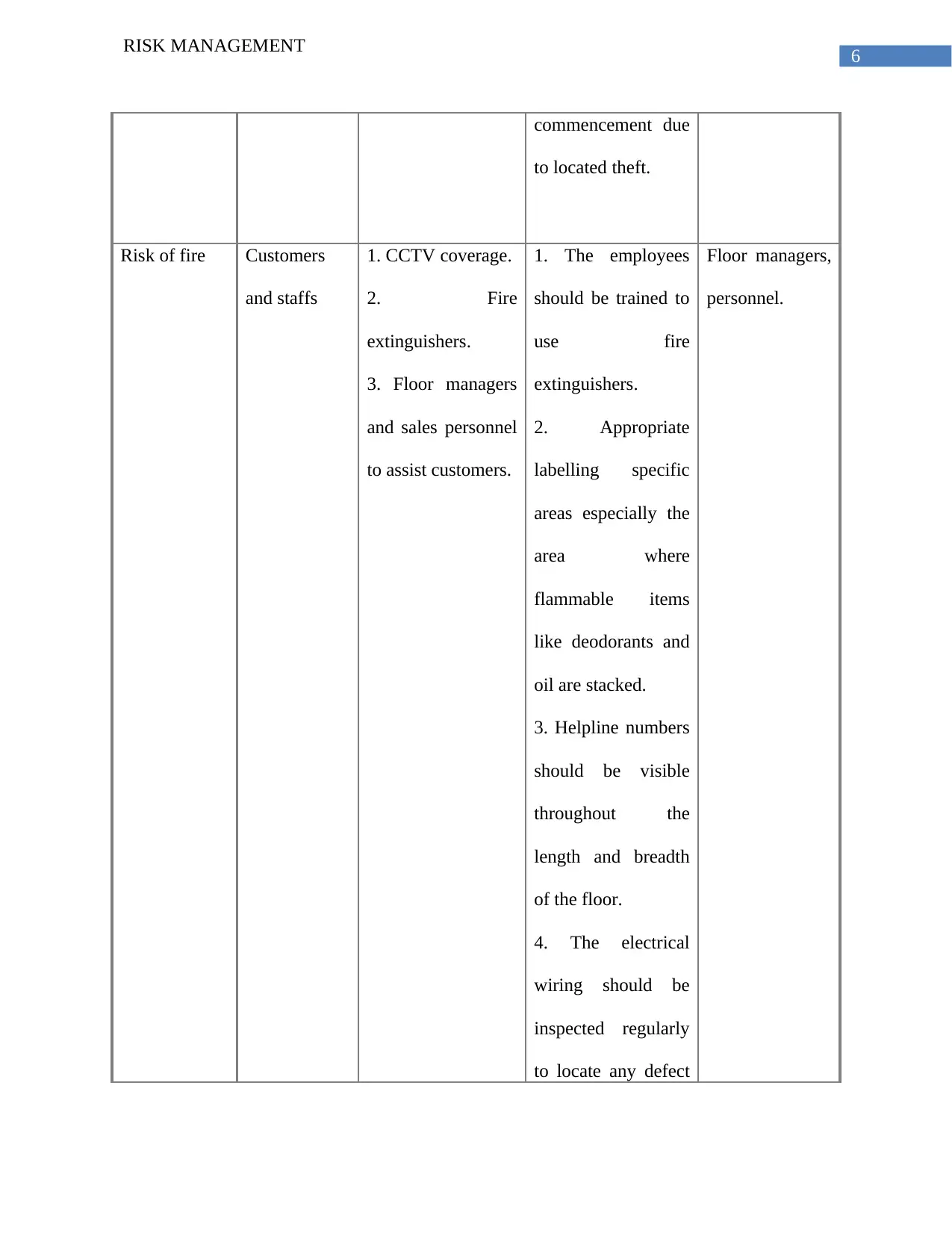
6
RISK MANAGEMENT
commencement due
to located theft.
Risk of fire Customers
and staffs
1. CCTV coverage.
2. Fire
extinguishers.
3. Floor managers
and sales personnel
to assist customers.
1. The employees
should be trained to
use fire
extinguishers.
2. Appropriate
labelling specific
areas especially the
area where
flammable items
like deodorants and
oil are stacked.
3. Helpline numbers
should be visible
throughout the
length and breadth
of the floor.
4. The electrical
wiring should be
inspected regularly
to locate any defect
Floor managers,
personnel.
RISK MANAGEMENT
commencement due
to located theft.
Risk of fire Customers
and staffs
1. CCTV coverage.
2. Fire
extinguishers.
3. Floor managers
and sales personnel
to assist customers.
1. The employees
should be trained to
use fire
extinguishers.
2. Appropriate
labelling specific
areas especially the
area where
flammable items
like deodorants and
oil are stacked.
3. Helpline numbers
should be visible
throughout the
length and breadth
of the floor.
4. The electrical
wiring should be
inspected regularly
to locate any defect
Floor managers,
personnel.
Paraphrase This Document
Need a fresh take? Get an instant paraphrase of this document with our AI Paraphraser
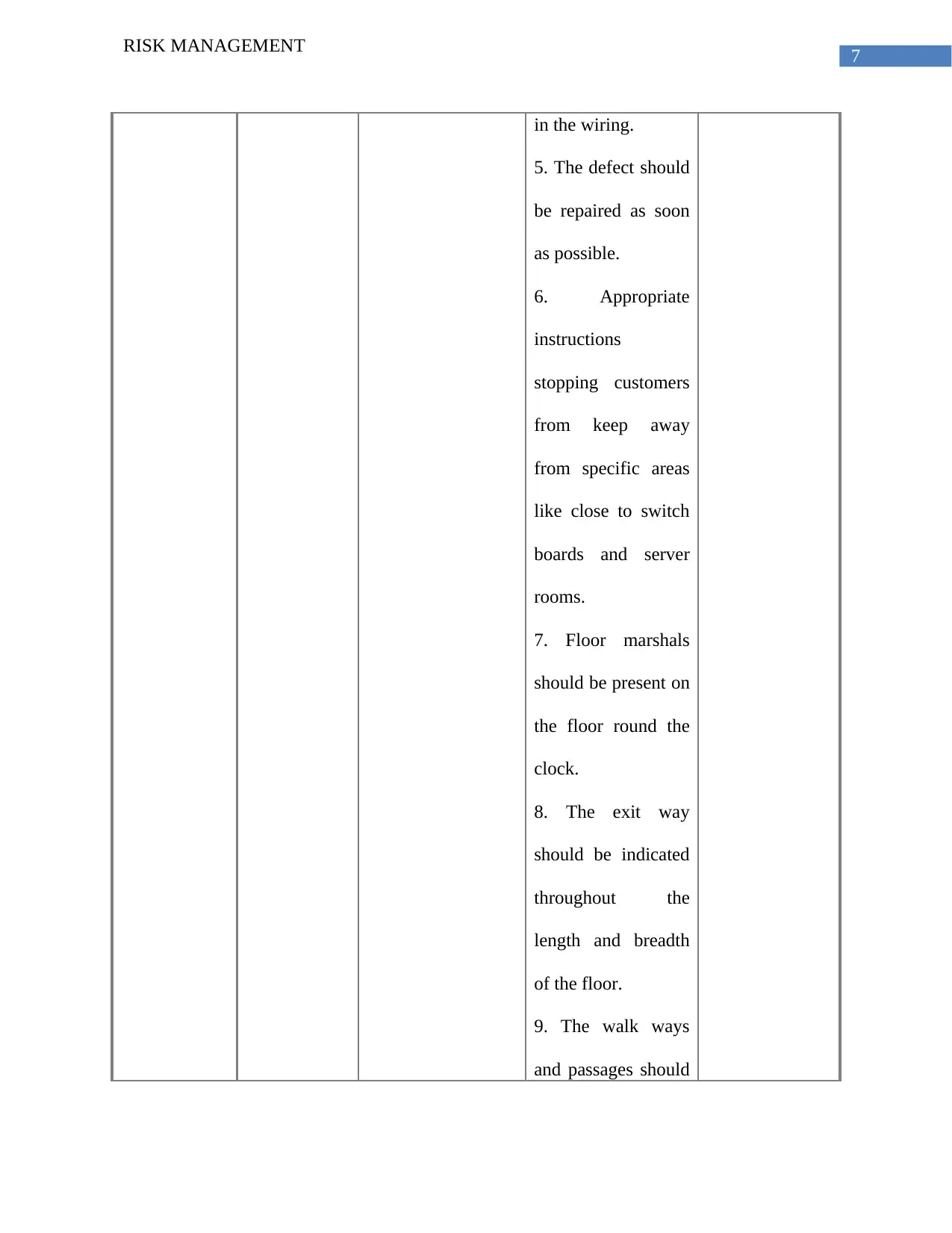
7
RISK MANAGEMENT
in the wiring.
5. The defect should
be repaired as soon
as possible.
6. Appropriate
instructions
stopping customers
from keep away
from specific areas
like close to switch
boards and server
rooms.
7. Floor marshals
should be present on
the floor round the
clock.
8. The exit way
should be indicated
throughout the
length and breadth
of the floor.
9. The walk ways
and passages should
RISK MANAGEMENT
in the wiring.
5. The defect should
be repaired as soon
as possible.
6. Appropriate
instructions
stopping customers
from keep away
from specific areas
like close to switch
boards and server
rooms.
7. Floor marshals
should be present on
the floor round the
clock.
8. The exit way
should be indicated
throughout the
length and breadth
of the floor.
9. The walk ways
and passages should
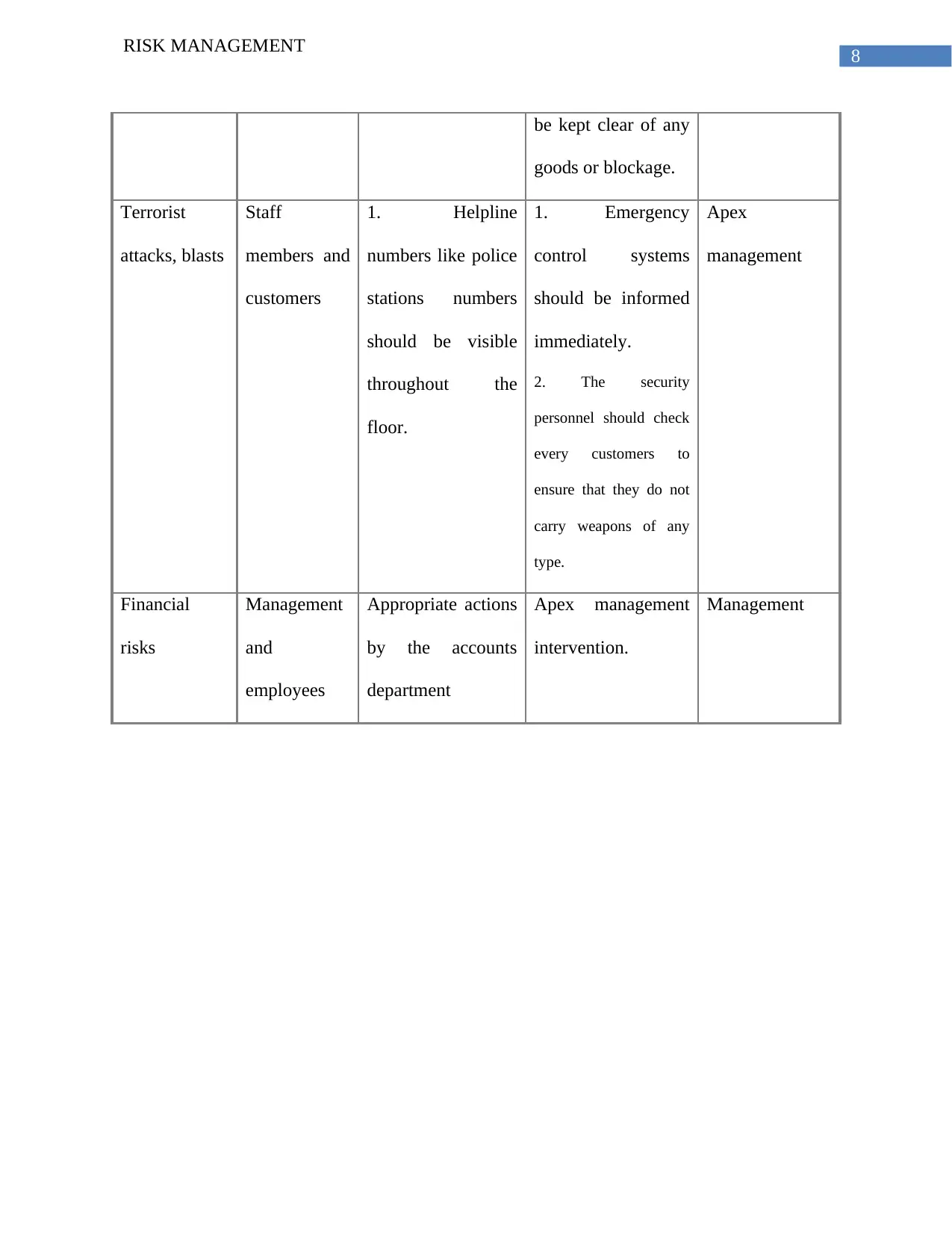
8
RISK MANAGEMENT
be kept clear of any
goods or blockage.
Terrorist
attacks, blasts
Staff
members and
customers
1. Helpline
numbers like police
stations numbers
should be visible
throughout the
floor.
1. Emergency
control systems
should be informed
immediately.
2. The security
personnel should check
every customers to
ensure that they do not
carry weapons of any
type.
Apex
management
Financial
risks
Management
and
employees
Appropriate actions
by the accounts
department
Apex management
intervention.
Management
RISK MANAGEMENT
be kept clear of any
goods or blockage.
Terrorist
attacks, blasts
Staff
members and
customers
1. Helpline
numbers like police
stations numbers
should be visible
throughout the
floor.
1. Emergency
control systems
should be informed
immediately.
2. The security
personnel should check
every customers to
ensure that they do not
carry weapons of any
type.
Apex
management
Financial
risks
Management
and
employees
Appropriate actions
by the accounts
department
Apex management
intervention.
Management
⊘ This is a preview!⊘
Do you want full access?
Subscribe today to unlock all pages.

Trusted by 1+ million students worldwide
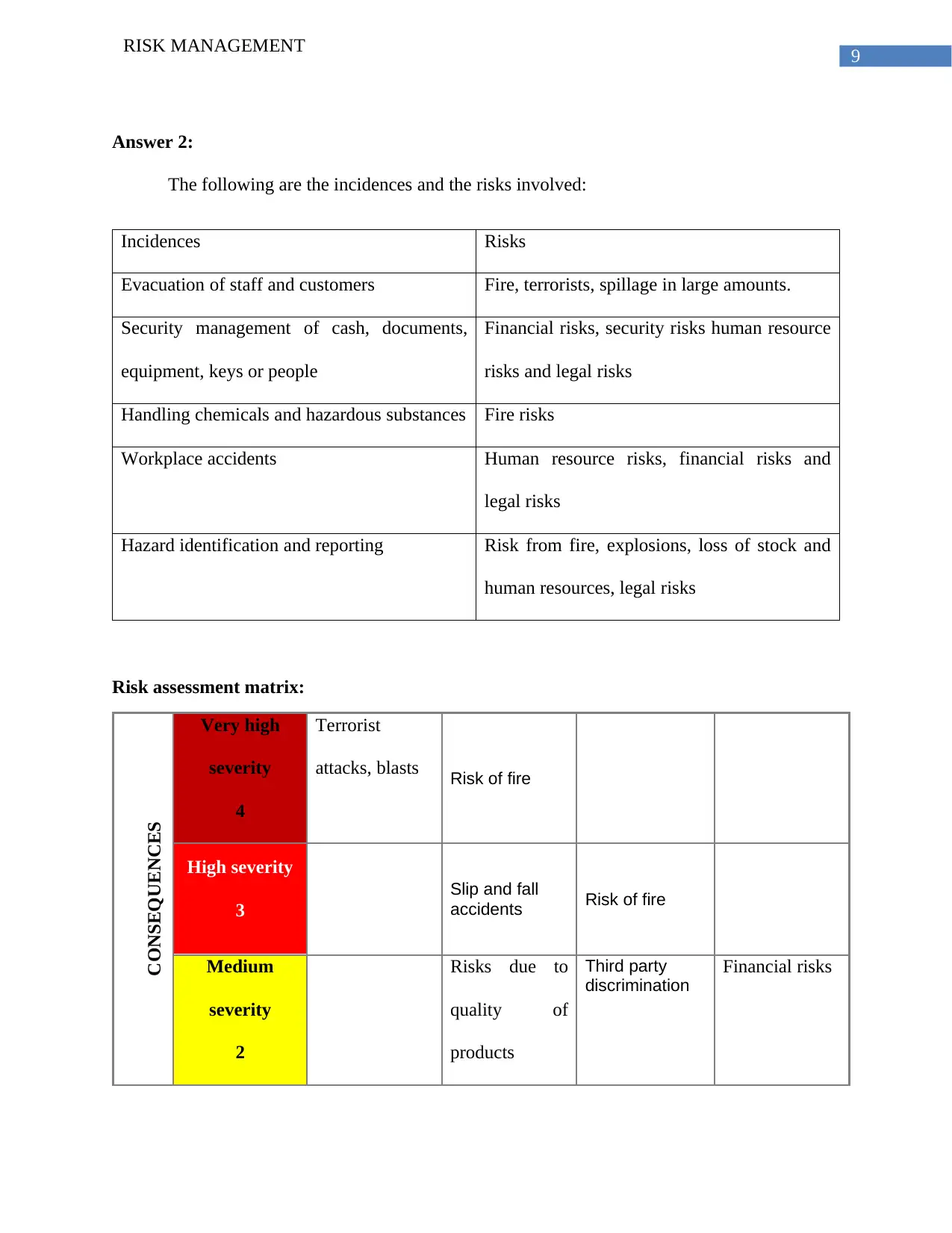
9
RISK MANAGEMENT
Answer 2:
The following are the incidences and the risks involved:
Incidences Risks
Evacuation of staff and customers Fire, terrorists, spillage in large amounts.
Security management of cash, documents,
equipment, keys or people
Financial risks, security risks human resource
risks and legal risks
Handling chemicals and hazardous substances Fire risks
Workplace accidents Human resource risks, financial risks and
legal risks
Hazard identification and reporting Risk from fire, explosions, loss of stock and
human resources, legal risks
Risk assessment matrix:
CONSEQUENCES
Very high
severity
4
Terrorist
attacks, blasts Risk of fire
High severity
3
Slip and fall
accidents Risk of fire
Medium
severity
2
Risks due to
quality of
products
Third party
discrimination
Financial risks
RISK MANAGEMENT
Answer 2:
The following are the incidences and the risks involved:
Incidences Risks
Evacuation of staff and customers Fire, terrorists, spillage in large amounts.
Security management of cash, documents,
equipment, keys or people
Financial risks, security risks human resource
risks and legal risks
Handling chemicals and hazardous substances Fire risks
Workplace accidents Human resource risks, financial risks and
legal risks
Hazard identification and reporting Risk from fire, explosions, loss of stock and
human resources, legal risks
Risk assessment matrix:
CONSEQUENCES
Very high
severity
4
Terrorist
attacks, blasts Risk of fire
High severity
3
Slip and fall
accidents Risk of fire
Medium
severity
2
Risks due to
quality of
products
Third party
discrimination
Financial risks
Paraphrase This Document
Need a fresh take? Get an instant paraphrase of this document with our AI Paraphraser
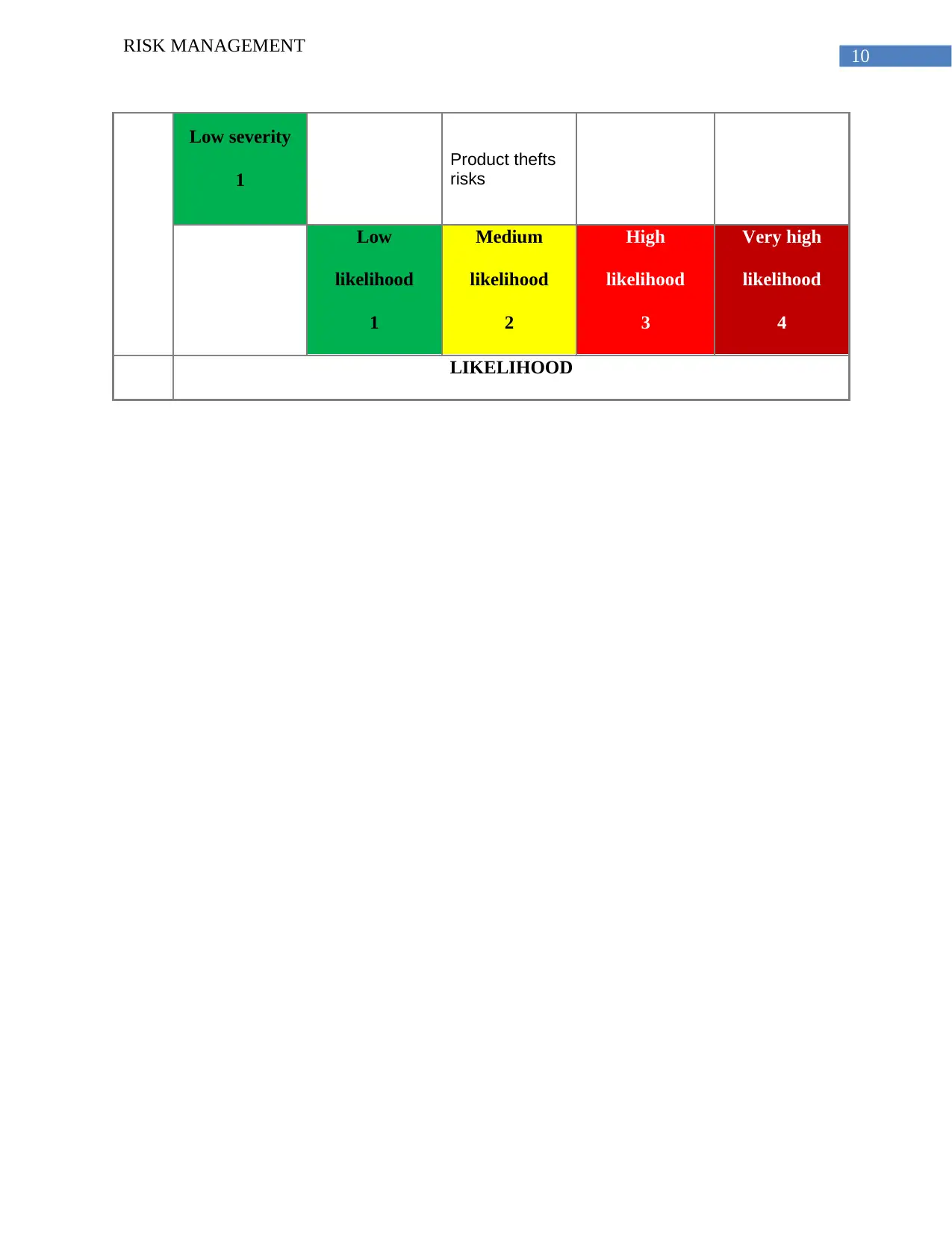
10
RISK MANAGEMENT
Low severity
1
Product thefts
risks
Low
likelihood
1
Medium
likelihood
2
High
likelihood
3
Very high
likelihood
4
LIKELIHOOD
RISK MANAGEMENT
Low severity
1
Product thefts
risks
Low
likelihood
1
Medium
likelihood
2
High
likelihood
3
Very high
likelihood
4
LIKELIHOOD
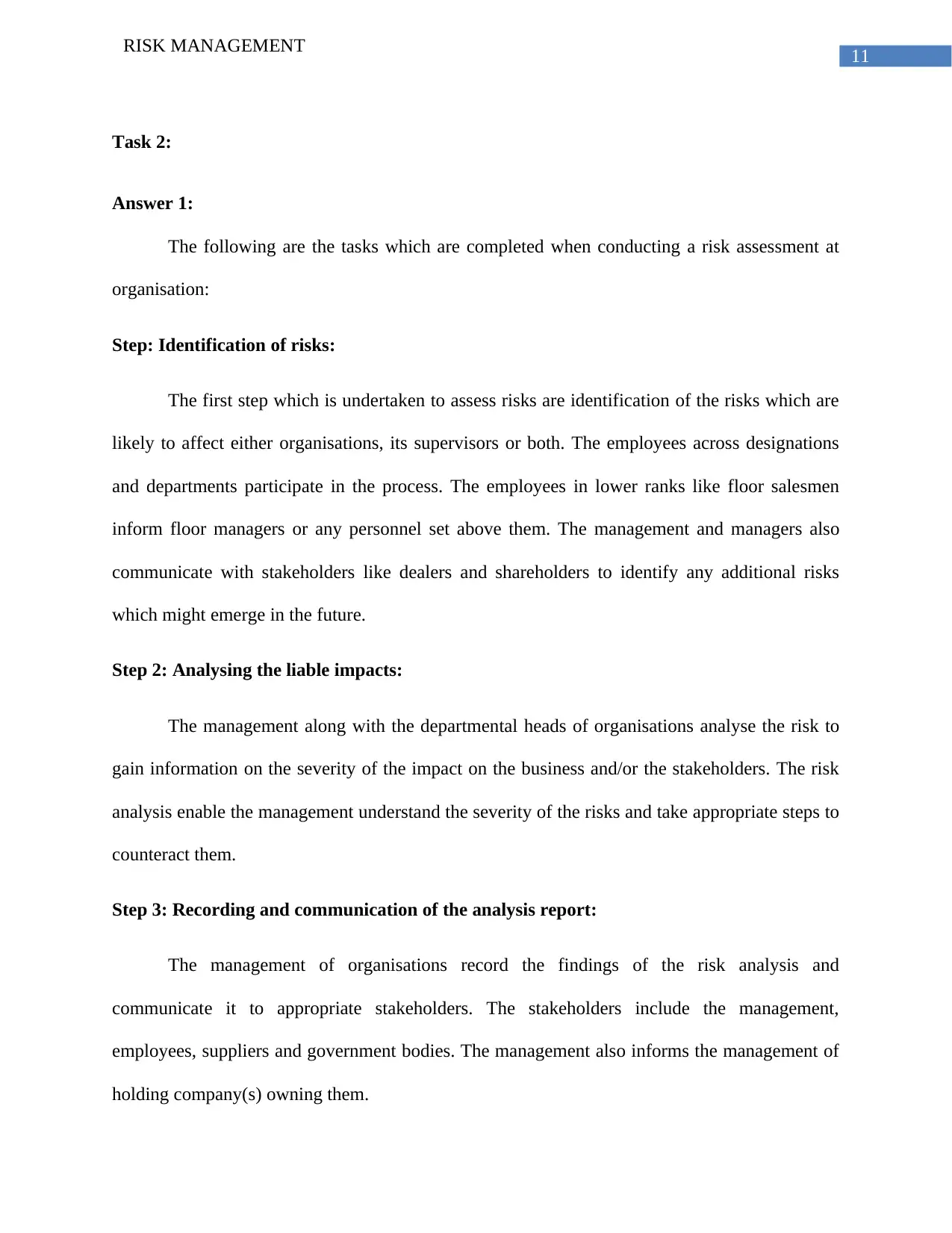
11
RISK MANAGEMENT
Task 2:
Answer 1:
The following are the tasks which are completed when conducting a risk assessment at
organisation:
Step: Identification of risks:
The first step which is undertaken to assess risks are identification of the risks which are
likely to affect either organisations, its supervisors or both. The employees across designations
and departments participate in the process. The employees in lower ranks like floor salesmen
inform floor managers or any personnel set above them. The management and managers also
communicate with stakeholders like dealers and shareholders to identify any additional risks
which might emerge in the future.
Step 2: Analysing the liable impacts:
The management along with the departmental heads of organisations analyse the risk to
gain information on the severity of the impact on the business and/or the stakeholders. The risk
analysis enable the management understand the severity of the risks and take appropriate steps to
counteract them.
Step 3: Recording and communication of the analysis report:
The management of organisations record the findings of the risk analysis and
communicate it to appropriate stakeholders. The stakeholders include the management,
employees, suppliers and government bodies. The management also informs the management of
holding company(s) owning them.
RISK MANAGEMENT
Task 2:
Answer 1:
The following are the tasks which are completed when conducting a risk assessment at
organisation:
Step: Identification of risks:
The first step which is undertaken to assess risks are identification of the risks which are
likely to affect either organisations, its supervisors or both. The employees across designations
and departments participate in the process. The employees in lower ranks like floor salesmen
inform floor managers or any personnel set above them. The management and managers also
communicate with stakeholders like dealers and shareholders to identify any additional risks
which might emerge in the future.
Step 2: Analysing the liable impacts:
The management along with the departmental heads of organisations analyse the risk to
gain information on the severity of the impact on the business and/or the stakeholders. The risk
analysis enable the management understand the severity of the risks and take appropriate steps to
counteract them.
Step 3: Recording and communication of the analysis report:
The management of organisations record the findings of the risk analysis and
communicate it to appropriate stakeholders. The stakeholders include the management,
employees, suppliers and government bodies. The management also informs the management of
holding company(s) owning them.
⊘ This is a preview!⊘
Do you want full access?
Subscribe today to unlock all pages.

Trusted by 1+ million students worldwide
1 out of 40
Your All-in-One AI-Powered Toolkit for Academic Success.
+13062052269
info@desklib.com
Available 24*7 on WhatsApp / Email
![[object Object]](/_next/static/media/star-bottom.7253800d.svg)
Unlock your academic potential
Copyright © 2020–2025 A2Z Services. All Rights Reserved. Developed and managed by ZUCOL.